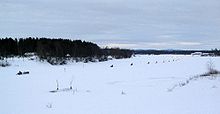Ivalojoki
| Ivalo | |
|---|---|

A snowmobile caravan on the frozen Ivalo River
|
|
| Native name | Ivalojoki Avviljohka |
| Country | Finland |
| Basin features | |
| Main source | Korsa Fjelds |
| River mouth |
Lake Inari 118.7 m (389 ft) |
| Physical characteristics | |
| Length | 180 km (110 mi) |
The Ivalo (Finnish: Ivalojoki, Northern Sami: Avviljohka, Inari Sami: Avveeljuuhâ) is a 180-kilometre (110 mi) long river that flows through upper Lapland into Lake Inari.
The Ivalo starts from the Korsa fjelds hugging the border between Inari and Enontekiö. The first streams branching off of it can be found on the bogs of Peltotunturi on the border between Finland and Norway along the western border of the Lemmenjoki National Park. The river flows into Lake Inari from a 5-kilometre (3 mi) long delta approximately 10 kilometres (6.2 mi) from the village of the same name, which is located on both banks of this meandering, shallow run. The Repo, Tolos, Sota and Kylä Rivers, the latter two of which are renowned for the gold found in them, are some of the Ivalo River's tributaries.
For almost its entire length, the Ivalo flows through wilderness. Near its headwaters, the river meanders as a narrow stream through the southernmost bogs of the Lemmenjoki National Park. Halfway down its length, the national park becomes the Hammastunturi Wilderness Area, through which it flows almost all the way to Ivalo.
The Ivalo has been nicknamed the "river of gold". During the Lapland gold rush at the end of the 19th century, places like Kultala were built. The movie Lapin kullan kimallus by director Åke Lindman portrays the height of the gold rush. Hundreds of gold claims, differing greatly in size, are still staked out along the banks of the river and its tributaries.
...
Wikipedia
